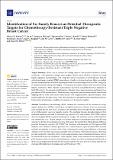| dc.contributor.author | Kohale, Ishwar N. | |
| dc.contributor.author | Yu, Jia | |
| dc.contributor.author | Zhuang, Yongxian | |
| dc.contributor.author | Fan, Xiaoyang | |
| dc.contributor.author | Reddy, Raven J. | |
| dc.contributor.author | Sinnwell, Jason | |
| dc.contributor.author | Kalari, Krishna R. | |
| dc.contributor.author | Boughey, Judy C. | |
| dc.contributor.author | Carter, Jodi M. | |
| dc.contributor.author | Goetz, Matthew P. | |
| dc.contributor.author | Wang, Liewei | |
| dc.contributor.author | White, Forest M. | |
| dc.date.accessioned | 2022-09-08T15:09:18Z | |
| dc.date.available | 2022-09-08T15:09:18Z | |
| dc.date.issued | 2022-08-30 | |
| dc.identifier.uri | https://hdl.handle.net/1721.1/145316 | |
| dc.description.abstract | Neoadjuvant chemotherapy (NAC) remains the cornerstone of the treatment for triple negative breast cancer (TNBC), with the goal of complete eradication of disease. However, for patients with residual disease after NAC, recurrence and mortality rates are high and the identification of novel therapeutic targets is urgently needed. We quantified tyrosine phosphorylation (pTyr)-mediated signaling networks in chemotherapy sensitive (CS) and resistant (CR) TNBC patient-derived xenografts (PDX), to gain novel therapeutic insights. The antitumor activity of SFK inhibition was examined in vivo. Treated tumors were further subjected to phosphoproteomic and RNAseq analysis, to identify the mechanism of actions of the drug. We identified Src Family Kinases (SFKs) as potential therapeutic targets in CR TNBC PDXs. Treatment with dasatinib, an FDA approved SFK inhibitor, led to inhibition of tumor growth in vivo. Further analysis of post-treatment PDXs revealed multiple mechanisms of actions of the drug, confirming the multi-target inhibition of dasatinib. Analysis of pTyr in tumor specimens suggested a low prevalence of SFK-driven tumors, which may provide insight into prior clinical trial results demonstrating a lack of dasatinib antitumor activity in unselected breast cancer patients. Taken together, these results underscore the importance of pTyr characterization of tumors, in identifying new targets, as well as stratifying patients based on their activated signaling networks for therapeutic options. Our data provide a strong rationale for studying SFK inhibitors in biomarker-selected SFK-driven TNBC. | en_US |
| dc.publisher | Multidisciplinary Digital Publishing Institute | en_US |
| dc.relation.isversionof | http://dx.doi.org/10.3390/cancers14174220 | en_US |
| dc.rights | Creative Commons Attribution | en_US |
| dc.rights.uri | https://creativecommons.org/licenses/by/4.0/ | en_US |
| dc.source | Multidisciplinary Digital Publishing Institute | en_US |
| dc.title | Identification of Src Family Kinases as Potential Therapeutic Targets for Chemotherapy-Resistant Triple Negative Breast Cancer | en_US |
| dc.type | Article | en_US |
| dc.identifier.citation | Cancers 14 (17): 4220 (2022) | en_US |
| dc.contributor.department | Massachusetts Institute of Technology. Department of Biological Engineering | |
| dc.contributor.department | Koch Institute for Integrative Cancer Research at MIT | |
| dc.contributor.department | Center for Precision Cancer Medicine | |
| dc.identifier.mitlicense | PUBLISHER_CC | |
| dc.eprint.version | Final published version | en_US |
| dc.type.uri | http://purl.org/eprint/type/JournalArticle | en_US |
| eprint.status | http://purl.org/eprint/status/PeerReviewed | en_US |
| dc.date.updated | 2022-09-08T13:24:02Z | |
| dspace.date.submission | 2022-09-08T13:24:02Z | |
| mit.license | PUBLISHER_CC | |
| mit.metadata.status | Authority Work and Publication Information Needed | en_US |
